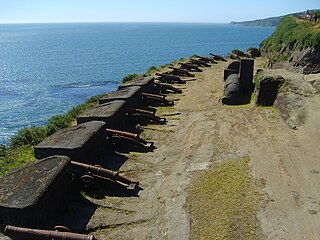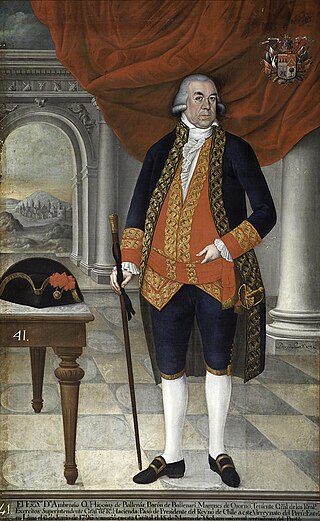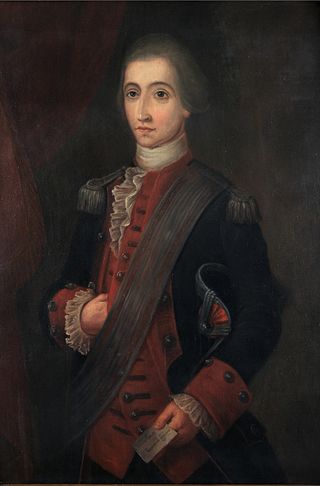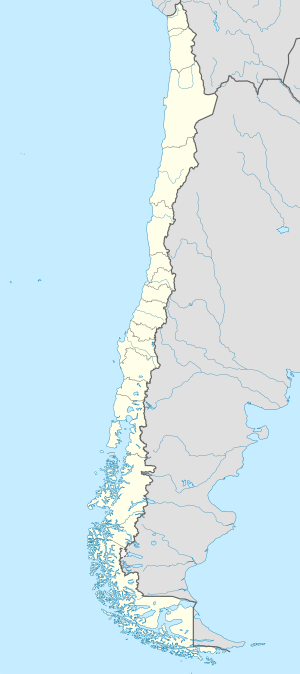
The Huilliche[wi.ˈʝi.tʃe], Huiliche or Huilliche-Mapuche are the southern partiality of the Mapuche macroethnic group of Chile. Located in the Zona Sur, they inhabit both Futahuillimapu and, as the Cunco subgroup, the north half of Chiloé Island. The Huilliche are the principal indigenous people of those regions. According to Ricardo E. Latcham the term Huilliche started to be used in Spanish after the second founding of Valdivia in 1645, adopting the usage of the Mapuches of Araucanía for the southern Mapuche tribes. Huilliche means 'southerners' A genetic study showed significant affinities between Huilliches and indigenous peoples east of the Andes, which suggests but does not prove a partial origin in present-day Argentina.

Osorno is a city and commune in southern Chile and capital of Osorno Province in the Los Lagos Region. It had a population of 145,475, as of the 2002 census. It is located 945 kilometres (587 mi) south of the national capital of Santiago, 105 kilometres (65 mi) north of the regional capital of Puerto Montt and 260 kilometres (160 mi) west of the Argentine city of San Carlos de Bariloche, connected via International Route 215 through the Cardenal Antonio Samoré Pass. It is a gateway for land access to the far south regions of Aysén and Magallanes, which would otherwise be accessible only by sea or air from the rest of the country.

The Fort System of Valdivia is a series of Spanish colonial fortifications at Corral Bay, Valdivia and Cruces River established to protect the city of Valdivia, in southern Chile. During the period of Spanish rule (1645–1820), it was one of the biggest systems of fortification in the Americas. It was also a major supply source for Spanish ships that crossed the Strait of Magellan.

Bueno River is a river in southern Chile. It originates in Ranco Lake and like most of Chile rivers it drains into the Pacific Ocean at the southern boundary of the Valdivian Coastal Reserve. Its lower flow forms the border between Osorno Province and Ranco Province. Traditionally it marks also the northern boundary of the indigenous Huilliche territory known as Futahuillimapu. The river passes through Río Bueno commune and city that takes name from the river.

The Chono people, or Guaiteco were a nomadic indigenous people or group of peoples of the archipelagos of Chiloé, Guaitecas and Chonos.
Cuncos or Juncos is a poorly known subgroup of Huilliche people native to coastal areas of southern Chile and the nearby inland. Mostly a historic term, Cuncos are chiefly known for their long-running conflict with the Spanish during the colonial era of Chilean history.

Ambrosio Bernardo O'Higgins y O'Higgins, 1st Marquess of Osorno born Ambrose Bernard O'Higgins, was an Irish-Spanish colonial administrator and a member of the O'Higgins family. He served the Spanish Empire as captain general of Chile (1788–1796) and viceroy of Peru (1796–1801). Chilean independence leader Bernardo O'Higgins was his son.

The Dutch expedition to Valdivia was a naval expedition, commanded by Hendrik Brouwer, sent by the Dutch Republic in 1643 to establish a base of operations and a trading post on the southern coast of Chile. With Spain and the Dutch Republic at war, the Dutch wished to take over the ruins of the abandoned Spanish city of Valdivia. The expedition sacked the Spanish settlements of Carelmapu and Castro in the Chiloé Archipelago before sailing to Valdivia, having the initial support of the local natives. The Dutch arrived in Valdivia on 24 August 1643 and named the colony Brouwershaven after Brouwer, who had died several weeks earlier. The short-lived colony was abandoned on 28 October 1643. Nevertheless, the occupation caused great alarm among Spanish authorities. The Spanish resettled Valdivia and began the construction of an extensive network of fortifications in 1645 to prevent a similar intrusion. Although contemporaries considered the possibility of a new incursion, the expedition was the last one undertaken by the Dutch on the west coast of the Americas.
The Parliament of Las Canoas was a diplomatic meeting between Mapuche-Huilliches and Spanish authorities in 1793 held at the confluence of Rahue River and Damas River near what is today the city of Osorno. The parliament was summoned by the Royal Governor of Chile Ambrosio O'Higgins after the Spanish had suppressed an uprising by the Mapuche-Huilliches of Ranco and Río Bueno in 1792. The parliament is historically relevant since the treaty signed at the end of the meeting allowed the Spanish to reestablish the city of Osorno and secure the transit rights between Valdivia and the Spanish mainland settlements near Chiloé Archipelago. The indigenous signatories recognized the king of Spain as their sovereign but they kept considerable autonomy in the lands they did not ceded. The treaty is unique in that it was the first time Mapuches formally ceded territory to the Spanish.
In Colonial times the Spanish Empire diverted significant resources to fortify the Chilean coast as consequence of Dutch and English raids. The Spanish attempts to block the entrance of foreign ships to the eastern Pacific proved fruitless due to the failure to settle the Strait of Magellan and the discovery of the Drake Passage. As result of this the Spanish settlement at Chiloé Archipelago became a centre from where the west coast of Patagonia was protected from foreign powers. In face of the international wars that involved the Spanish Empire in the second half of the 18th century the Crown was unable to directly protect peripheral colonies like Chile leading to local government and militias assuming the increased responsibilities.
Juan Antonio Garretón was a Spanish army officer who served in different positions in Colonial Chile and Chiloé.

The Governorate of Chiloé was political and military subdivision of the Spanish Empire that existed, with a 1784–1789 interregnum, from 1567 to 1826. The Governorate of Chiloé depended on the Captaincy General of Chile until the late 18th century when it was made dependent directly on the Viceroyalty of Peru. The administrative change was done simultaneously as the capital of the archipelago was moved from Castro to Ancud in 1768. The last Royal Governor of Chiloé, Antonio de Quintanilla, depended directly on the central government in Madrid.
The battle of Río Bueno was fought in 1654 between the Spanish Army of Arauco and indigenous Cuncos and Huilliches of Fütawillimapu in southern Chile. The battle took place against a background of a long-running enmity between the Cuncos and Spanish, dating back to the destruction of Osorno in 1603. More immediate causes were the killing of Spanish shipwreck survivors and looting of the cargo by Cuncos, which led to Spanish desires for a punishment, combined with the prospects of lucrative slave raiding.
The Mapuche uprising of 1655 was a series of coordinated Mapuche attacks against Spanish settlements and forts in colonial Chile. It was the worst military crisis in Chile in decades, and contemporaries even considered the possibility of a civil war among the Spanish. The uprising marks the beginning of a ten-year period of warfare between the Spanish and the Mapuche.
Andrés Febrés was 18th-century Spanish Jesuit active in Colonial Chile. He is best known for his book Arte de la lengua general del Reyno de Chile, con un diálogo chileno-hispano muy curioso : a que se añade la doctrina christiana, esto es, rezo, catecismo, coplas, confesionario, y pláticas, lo más en lengua chilena y castellana : y por fin un vocabulario hispano-chileno, y un calepino chileno-hispano mas copioso. Lima. 1765. p. 465.
Futahuillimapu or Fütawillimapu is a traditional territory of the Huilliche people. Futahuillimapu spans the land between Bueno River and Reloncaví Sound. Futahuillimapu means "great land of the south."
The Mission of Río Bueno was a Franciscan mission in the Huilliche lands in Río Bueno, next to Bueno River, southern Chile.
The Battle of Río Bueno in 1759 was a military engagement between Spanish colonial forces and local Huilliche in the Bueno River of south-central Chile. The battle was fought on January 27 with the Spanish forces led by Juan Antonio Garretón. The battle of 1759 was an exception to the overall policy of befriending indigenous communities on behalf of the Spanish authorities in Valdivia.

Tomás de Figueroa y Caravaca was a Spanish soldier. He was active in the military outpost of Valdivia and later in Santiago as a royalist during the early phase of the Chilean struggle for independence. He was born in Estepona, near Málaga in southern Spain. A soldier by profession, he had to migrate Chile in 1775 after having killed a man in a duel in Spain. In late 1792 he led Spanish forces that suppressed a Huilliche uprising around Río Bueno and Futahuillimapu in southern Chile. After leading a mutiny to restore colonial order in Santiago on April 1, 1811, he was summarily executed on the orders of pro-independence leader Juan Martínez de Rozas.
The 1651 wreckage of San José and the subsequent killings and looting carried out by indigenous Cuncos was a defining event in Colonial Chile that contributed to Spanish-Cunco tensions that led to the Battle of Río Bueno and the Mapuche uprising of 1655.









